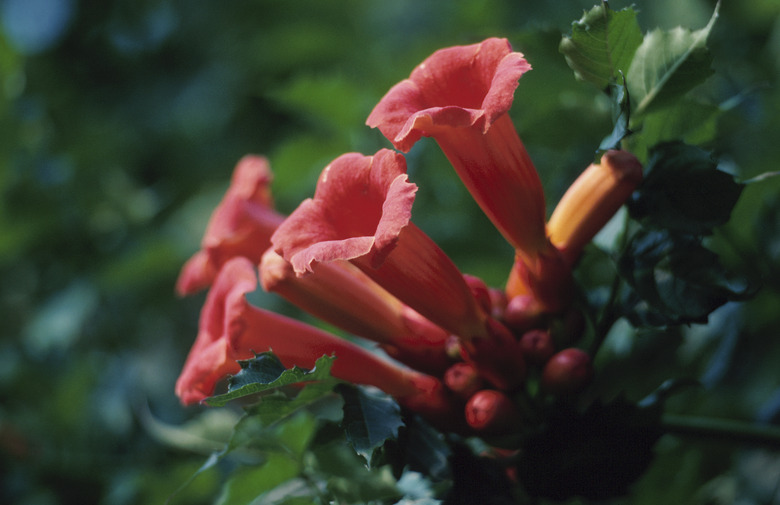Trumpet Vine Diseases
Trumpet vine or trumpet creeper (Campsis radicans) is a woody plant that produces orange flowers that resemble trumpets. Trumpet vines are hardy and invasive, growing in United States Department of Agriculture plant hardiness zones 4-10. The few diseases that affect the vitality of the plant can be prevented or controlled.
Types
Trumpet vines can get powdery mildew infections and fungal leaf spots. Powdery mildew is a fungal disease of trumpet vines that also affects a wide variety of ornamental plants. More than 1,000 species of fungi cause powdery mildew infections. Trumpet vines are susceptible to various leaf spot infections. However, these are a minor disease of trumpet vines.
- Trumpet vine or trumpet creeper (Campsis radicans) is a woody plant that produces orange flowers that resemble trumpets.
- Trumpet vines can get powdery mildew infections and fungal leaf spots.
Symptoms/Identification
Powdery mildew infections cause a white to gray, powdery coating on trumpet vine leaves. It first appears as blotches of white fungal growth on infected portions of the leaves. As the disease progresses, the fungus spreads over the surface of infected areas and turns gray to tan. Uncontrolled, the infection stunts leaf growth and reduces vigor, and causes premature leaf drop and leaf curl. Fungal leaf spots are small, irregular to circular spots with a tan to black color. Their damage is cosmetic, but severe infestations can cause leaves to yellow and drop.
Favorable Conditions
Powdery mildew fungi develop when daytime temperatures are warm and nights are cool and humid. Poor air circulation also puts the vines at risk. The fungi can overwinter on infected fallen leaves and tissue, which can cause reinfection. Leaf spot fungal pathogens favor free moisture on leaf surfaces, high humidity and poor air circulation. Infection occurs in mid spring to early summer during rainy conditions. Like powdery mildew, leaf spot diseases can overwinter on infected fallen leaves.
- Powdery mildew infections cause a white to gray, powdery coating on trumpet vine leaves.
- Like powdery mildew, leaf spot diseases can overwinter on infected fallen leaves.
Control/Management
Prevent powdery mildew infections by providing good air circulation, keeping the trumpet vine healthy and removing and destroying fallen infected leaves. Mild to moderate infections rarely warrant chemical control because they cause cosmetic damage rather than long-term damage. However, chemical fungicides can help control severe cases that threaten the vitality of the plant. Remove and destroy infected leaves to prevent leaf spot infections from spreading. Increase air circulation by pruning overgrown vines to prevent infection from leaf spot fungi. Because leaf spot diseases rarely cause significant damage to the vine, fungicides aren't necessary.
References
- United States Department of Agriculture Natural Resources Conservation Service; Trumpet Creeper; Mark Skinner; June 2006
- University of Illinois Extension; Powdery Mildew of Ornamentals; 1987
- University of Illinois Extension; Fungal Leaf Spot Diseases of Shade and Ornamental Trees in the Midwest; 1998
